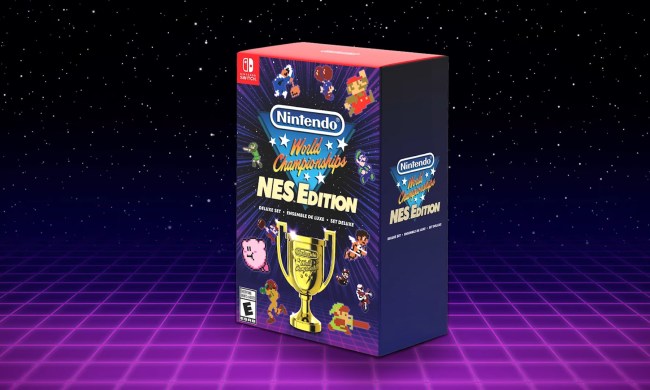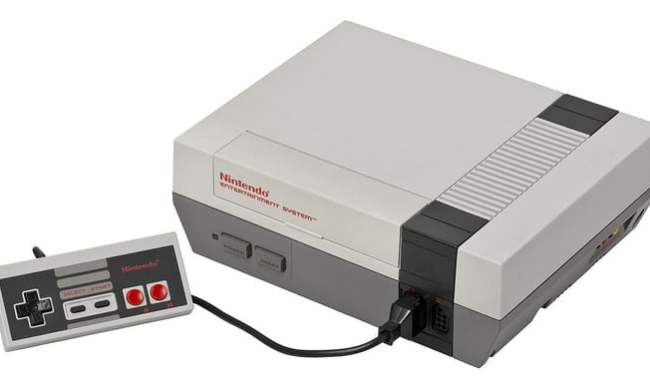
“Nintendo World Championships: NES Edition will teach you the thrill of speedrunning, but it's only a tease.”
- Solid game selection
- Great intro to speedrunning
- Legendary challenges are fun
- Lots of unlockables
- Missing any context about real NWC
- Poorly built local multiplayer
- Competitive modes are lacking
- Doesn't include the full NES games
My hands are dripping with sweat. I’m not sure if it’s from the 90-degree summer heat or if that’s just the adrenaline coursing through my veins. I’m determined to set a personal record. I take control of a pixelated Mario and run hurtling to the familiar row of item boxes that greet players at the beginning of Super Mario Bros. I hop over a Goomba, hit a box to unleash a mushroom and jump to it. I’m fast, but not fast enough. Reset. This time I mistime my jump and hit the wrong box. Reset. I slide a few pixels too far and lose my momentum. Reset. It takes dozens of tries, but I eventually lock in. I hit my first and second jumps perfectly, run left, hop on top of the boxes with my momentum, and nab the roaming fungus.
I’ve done it. I’ve beaten my previous record by .1 second. Now I’m cheering like I’ve just won an Olympic medal.
It may sound silly, but that’s the thrill that Nintendo World Championships: NES Edition delivers to those willing to fully commit to it. The microgame collection turns 13 NES classics into a series of bite-sized speed challenges that encourage players to get intimately familiar with how old games were designed and the nuances that make each one special. It’s a great playable history lesson, though one that struggles to translate obsessive single-player fun into competitive modes that live up to its namesake event.
The joys of speed
Nintendo World Championships: NES Edition has a bit of a misleading title. You might think that you’re getting a faithful re-creation of the actual Nintendo World Championships series, a live competition that first took place in 1990. That’s not really the case. The real event had players competing to set high scores in modified versions of Super Mario Bros., Rad Racer, and Tetris playing off a special NES cartridge built for the event. This collection more so turns Nintendo’s most iconic first-party NES games into around 150 short speed challenges that take anywhere from two seconds to seven minutes to complete. It would be more accurate to call it NES Remix 3, but without the actual “remix” part.
I’m initially disappointed when I first boot it up. It’s not so much that it doesn’t match the real event. It’s more that it doesn’t do much of anything to celebrate it beyond a short splash screen explaining what it was briefly. It’s lacking as a historical document, and that does cut into the appeal at first. Without context on the real competition, like archival footage driving home how tense the event was, it’s hard for me to find much motivation at first as I work through some simple challenges from games I’ve played hundreds of times.
That changed faster than I expected. Once it got its hooks in me, I couldn’t stop.

The core of the experience is in Speedrun mode, where players can freely play every minigame and try to set their best time. The collection pulls challenges from 13 games, including Metroid, The Legend of Zelda, Excitebike, and every 2D Mario platformer from the NES era (including The Lost Levels). It’s a great spread of classics that gives underappreciated gems like Balloon Fight and Kid Icarus time to shine. The challenges mount in complexity as I play, split up by difficulty ranks. Sometimes all I need to do is inhale an enemy in Kirby’s Adventure, a task that takes seconds. Other times, I have to clear an entire level of it. The bite-sized nature of those challenges makes it easy to replay them over and over in search of perfection.
What Nintendo World Championships nails so well is the unique thrill of speedrunning. I’ve always felt I could only ever enjoy as a spectator, but the package is the teacher I always needed. It accomplishes that in an ingenious way. Take its Super Mario Bros. challenges, for instance. At first, they’re simple. I learn how to nab a mushroom, get up a staircase with ease, and reach the hidden warp zone in 1-2 quickly. The more I replay each one, the more I gain mastery over a specific skill. That all builds to the game’s “Legendary” challenge, where I need to speedrun the entire game using the skills I’ve just learned. A task that previously seemed daunting now becomes simple; I know exactly how to get to each warp zone quickly and the right places I need to jump to keep myself from getting hung up. I feel like I’ve just passed a crash course when I finally pull it off.
I was picking up my Switch multiple times a day and shaving milliseconds off challenges.
The education lesson goes beyond that niche appeal, though. As I try to set high scores in each game’s challenges, I become much more familiar with how each is built. I can feel how something as simple as a jump can make two games feel entirely different. A lack of air control turns Ice Climber into an unbearably stiff platformer that requires unforgiving precision, while Kid Icarus feels like a more flexible and fluid adventure that leaves lots of room for me to perfect my best time. Even from three decades of playing these games, I’ve never appreciated them as much as I did here. It’s an ode to game design that had me dissecting each game like a scientist.
Before I knew it, I’d spent over 15 hours almost exclusively playing Speedrun mode. I was driven to perfect my time in as many games as possible as I racked up S-ranks and unlocked some badges and icons to display on my online profile. I became a master of Donkey Kong in a few days, getting as close to a perfect time as possible on most of its challenges. Even when it felt like I’d exhausted that loop, I was still picking up my Switch multiple times a day and shaving milliseconds off challenges. I can even see my previous best time on a screen next to mine, letting me race against myself and see my best splits. The adrenaline has yet to wear off even now as I continue to chip down my combined time for the entire suite of minigames. I don’t see myself stopping anytime soon.
Losing competitive edge
While that core hook is a powerful one, Nintendo World Championships fumbles when it tries to then apply those skills to competition. Of the included modes, the most successful one is a Legendary Trial that has me completing the final challenges for all 13 games in a gauntlet that initially takes me 40 minutes to finish. It’s a workout as I bounce from completing a full climb in Ice Climbers to clearing the entirety of a dungeon in Zelda 2: The Adventures of Link. When I finish, I’m determined to practice each one again and study where I can shave my time down on my next go-around.
The package falters more in its proper multiplayer offerings, as each mode comes with a big concession. The worst offender is its local Party Mode, which supports up to eight players on one TV. It’s a great concept in theory as friends race against each other over a series of challenges. That’s let down by two caveats. For one, players either select single minigames one by one or pre-built packs that include a few specific ones. There’s no way to build your own playlist nor is there any sort of “random” option that makes each session less predictable.

To make matters worse, Nintendo World Championships uses a bizarre split-screen solution that I can’t wrap my head around. Each screen appears as a tiny square with tons of empty space around it. When my friends first saw how tiny our screens were in five-player mode, one person volunteered to sit out so we could get a proper four-quadrant split that gave us bigger screens. Instead, our tiny squares were placed in a straight line that ran from edge to edge of the TV. It’s like the developers went out of their way to keep screens as small as possible, making it difficult to play with precision unless you’re on a massive TV. My pals and I still found ourselves able to get into the competitive spirit, but even the less picky players in the group were in disbelief at how it’s handled.
I hoped that its online offerings would make up for those local shortcomings, but the two extra modes offered don’t quite provide an outlet for my acquired skills either. The better mode of the two is World Championships mode, a weekly event where every player is given the same set of five minigames and tasked with submitting the best possible scores they can muster in each by the end of the week. At the end, global leaderboards show the winners. It’s a great way to get out of Speedrun mode and put those skills to the test, but it’s a bit disappointing that the games aren’t played in one continuous suite. Instead, I just keep playing the individual challenges as many times as I want through the week, making it more of an extension of Speedrun mode.
Survival Mode tries to offer that experience, but in a disappointingly limited way. In another weekly format, players jump into eight-player elimination matches where they have to come out on top in a three-minigame gauntlet. It’s the kind of competition I crave in theory, but it isn’t substantial enough of a challenge. I only race the ghost data of seven other players, whom I could beat without much effort in both a Silver and Gold playlist. I only have to complete three minigames in each, which means that it’s all over in under two minutes depending on what games are selected each week. Once I come out on top, I have to wait another week for the minigames to change. It’s only an excuse to log in each week for mere minutes of unsatisfying races that aren’t even against live players (something that I imagine wouldn’t be terribly feasible on Nintendo’s tenuous online infrastructure).
It feels more like practice than the big game itself.
I could live with those underdeveloped modes if Nintendo World Championships didn’t have one glaring omission: It doesn’t include the full NES games featured in it. After completing challenges, I can’t go play a full game of Donkey Kong. It’s a frustrating tease. After spending hours learning the ins and outs of that game, all I want to do is see how I can apply my skills to the whole thing. It’s a cheap move from a company that’s become notoriously stingy about giving away old games. The package ends up feeling like an ad for Nintendo Switch Online’s retro game catalog, as you’ll have to subscribe if you want to go play those games legally after getting an itch for them.
While I’ll surely continue to chip away at my best times, Nintendo World Championships: NES Edition feels more like practice than the big game itself. It’s a great way to learn the basics of speedrunning, but the outlet for those acquired skills is in another castle. Maybe it’s all building toward the return of the real Nintendo World Championships. If that’s the case, cue the ’80s training montage music. I’m going big time.
Nintendo World Championships: NES Edition was tested on Nintendo Switch OLED.



